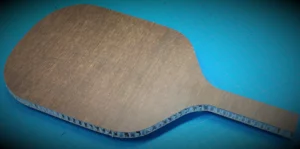Woven Fabric Style Guide
When selecting a woven fabric, knowing the various design elements offers an understanding of what available options are best suited for specific applications. There are four basic variables to consider: the weight of the yarn, the thread count of the woven fabric, the weave pattern, and the fabric finish. These attributes determine the strength, weight, thickness, and usability of the woven fabric.
WHAT IS A WOVEN FABRIC?
A woven fabric is a flat, pliable structure produced by interlacing a series of filling yarns with a series of warp yarns at right angles a specific pattern. The filling yarns are inserted by a shuttle that traverses the yarns from one side of the warp to the other interlacing the two systems of yarns, in a prearranged weave pattern.
Filling yarns are the tow (ribbon) that is 90° to the edge and run along the width.
Warp yarns are parallel to the edge and run lengthwise.
Thread count is the number of warp yarns and filling yarns per inch of fabric. Warp yarn x Fill yarn
DIFFERENT FIBER TYPES
The typical fibers used in woven fabrics are Fiberglass, Carbon, and KEVLAR®. Fiberglass fibers are going to be either E Glass or S-2 Glass®. E-Glass fibers are the most widely used all-purpose fiberglass fiber available and the S-2 Glass® is the commercial version of high strength S-Glass developed by Owens-Corning. Carbon fibers, sometimes called Graphite, are one of the strongest and stiffest fiber types available. The carbon fibers are offered with low, intermediate, and high strength properties. KEVLAR® fibers offer a unique combination of high strength, high modulus and flexibility.
Also available are Hybrid woven fabrics, which consist of two different fibers such as KEVLAR® and Carbon fibers or Carbon and S-2 Glass®. A Hybrid fabric of would exhibit combined properties.
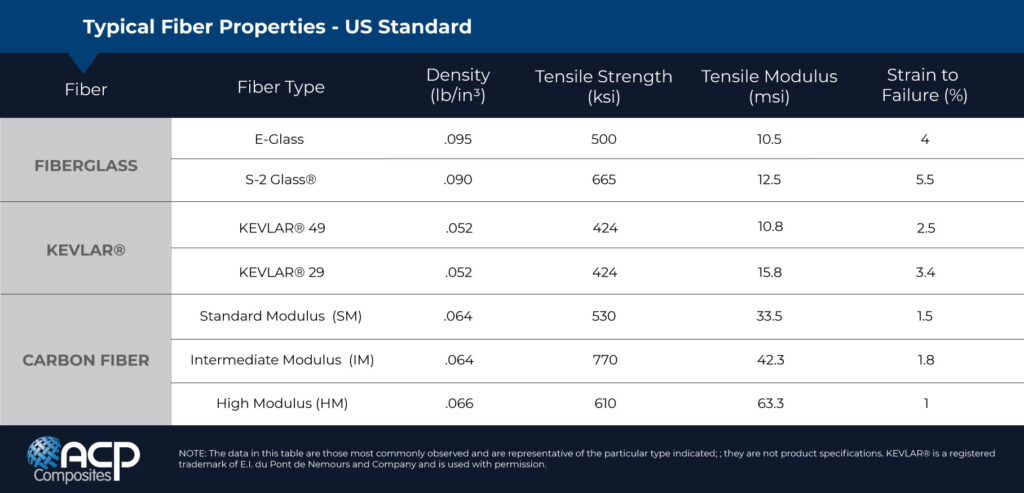
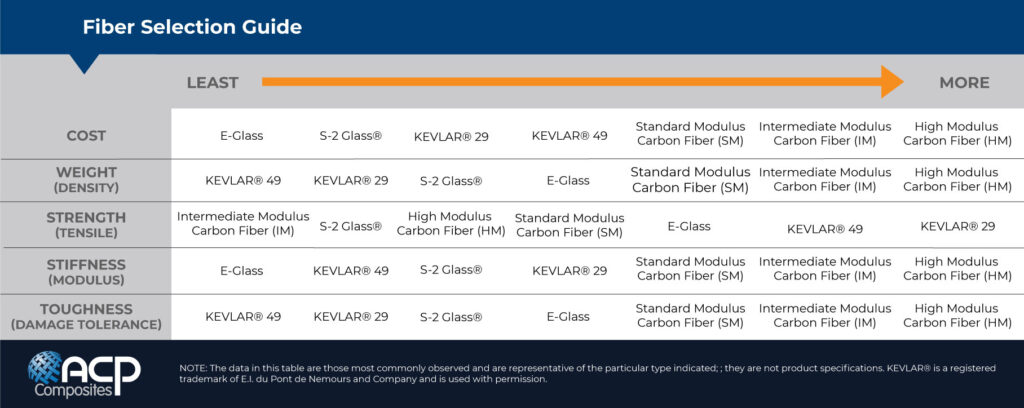
WEAVE PATTERNS
There are several weave patterns that can be woven. The most common weaves are Plain Weaves, Twill Weaves, and Satin Weaves. Within each weave pattern there will be variance based on the thread counts and the style of the weaves.
Plain Weave
In a plain weave, the warp and fill yarns cross over and under one another. The frequent over/under weaving of the threads reduces the overall strength of fabric, but still produces a fabric that is suited for all but the highest performance applications. Plain woven fabrics are generally the least pliable, and do not unravel easily. Plain weave fabrics are ideally suited for flat applications where drape and conformability are not required.

Satin Weave
Satin weave produces a more flexible fabric than a plain weave. The fill yarn “floats” over several warp yarns before interlacing under one. Common satin weaves are 4-Harness Satin, 5-Harness Satin and 8-Harness Satin.
- 4-Harness Satin Weave (4HS) – In the 4HS, also called Crowfoot Satin, the fill yarn passes over three warp yarns and under one. It is more pliable than a plain weave and forms easily around curves.
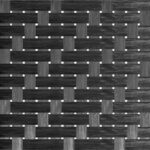
- 5-Harness Satin Weave (5HS) – In the 5-Harness Satin weave the fill yarn floats over four warp yarns and under one. It is more pliable than the plain weave and easily conforms to curved surfaces.

- 8-Harness Satin Weave (HS) – The 8-Harness Satin weave (8HS) is the fill yarn floats over seven warp yarns and under one. It is the most pliable satin weave and forms well around compound curves.

Twill Weave
Twill weave is similar to satin weaves in that the fill yarns float over several intersections. Twill weaves have a characteristic diagonal rib formed by the interlace points in the fabric. The rib is called the “twill” or “twill line”. The 2×2 Twill weave is the most popular weave for cosmetic or decorative applications.
2×2 Twill Weave– The 2×2 Twill weave pattern is characterized by a two-by-two weave where two warp yarns float over two fill yarns, creating a diagonal appearance. The twill weave is more pliable than the plain weave and has better drapability while maintaining more fabric stability than a harness satin weave. It is recommended for use on parts that have compound curves.
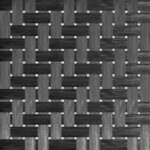
Leno Weave
With a leno weave, two warp yarns are twisted around the weft yarns to provide a strong fabric with open structures or small gaps. This construction method locks the yarns in place to produce an open fabric with almost no yarn slippage or misplacement of threads. However, because of the openness, leno weaves are often used in combination with other weave styles.
Mock Leno
Mock Leno weaves, sometimes referred to as imitation leno weaves, are modified versions of a plain weave pattern in which there is a deviation of the over-under interlacing of the warp fiber. This creates a fabric that takes on the appearance of a gauze or leno weave and overall, produces a fabric with increased thickness, rougher surface and additional porosity.
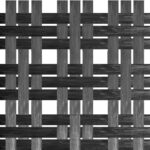
YARN WEIGHT AND THE THREAD COUNT
Fabric thickness and weight can be determined by the size of yarn and thread count of each woven fabric. Yarn (tow) is what is used to weave fabrics and is available in many sizes. The size is controlled by the number of filaments per strand. Common sizes are 1K, 3K, 6K, 12K, and 50K. The K refers to thousands, so for example the 3K yarns would have 3,000 filaments per strand and the 6K would have 6.000 filaments per strand.
The thread count of a woven fabric controls how tight the weave is; the more warp and fill yarns per inch results in a tighter woven fabric. Tighter weave fabrics would most likely be used for flatter applications as the tighter weave allows for a stiffer fabric. Loose woven fabrics offer more flexibility and are likely to be used as a finishing fabric or in an application with curved features
FABRIC FINISHES
Fabric finishes are applied in the final stage of creating a woven fabric and mostly used with fiberglass. When the fabric comes off the loom it is still untreated, or “in the greige”. In order for the fabric to be compatible with resin systems it must first be heat cleaned and then treated in a chemical bath, called “finishing.” The finish allows for adhesion between the fibers and the resin systems, sets the fabric weave, provides fabric stability and protection.
KEVLAR® is a registered trademark of E.I. du Pont de Nemours and Company and is used with permission.

